October 16, 2020
Air Date: October 16, 2020
FULL SHOW
SEGMENTS
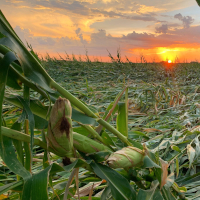
Prairie Senate Races Show Climate Divide
View the page for this story
Iowa’s Senate seat is hotly contested in this election, and the Senate race in Kansas appears tighter than it has been in decades. Both states are experiencing increasingly erratic and destructive weather linked to the warming of the planet. Reporter Georgina Gustin has covered the climate rhetoric of the Iowa and Kansas Senate races for InsideClimate News, and joins Host Bobby Bascomb to discuss the divide between these mid-America Democratic and Republican senate candidates on climate change. (07:16)
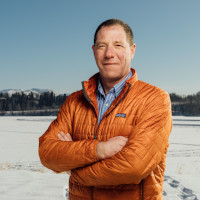
Beyond the Headlines
/ Peter DykstraView the page for this story
In this week’s edition of Beyond the Headlines, Environmental Health News Editor Peter Dykstra takes Host Steve Curwood behind the scenes of the suddenly competitive Senate race in Alaska, where the GOP incumbent faces pushback over the Pebble Mine with its risk of runoff that could threaten the world’s largest sockeye salmon fishery. Next, the pair put on their bug nets and entomologist hats to review the possible ecological dangers which might accompany the arrival of the giant ‘Murder Hornet’ in Washington State and its danger to honeybees. Finally, in a look back at this week in history, Peter marks the passage of the Toxic Substances Control Act of 1976, or TSCA, which strengthened chemical regulation in the US. (05:01)

Note on Emerging Science: Puffins Use Tools
View the page for this story
Crows are known to use tools, and now the first time, scientists have documented the use of tools by the puffin, a black and white seabird found in the North Atlantic. Living on Earth’s Don Lyman reports on the finding that puffins use sticks to scratch their beaks and feathers, the first documentation of tool use in seabirds. (01:22)
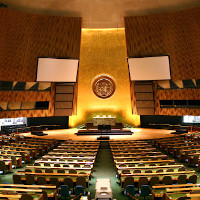
China Leads on Climate
View the page for this story
At the annual UN General Assembly, President Xi of China pledged that his nation would peak its carbon emissions before 2030 and hit net zero emissions by 2060, without revealing how the nation plans to reach those goals. Joe Aldy, an economist and Professor of Public Policy at Harvard's Kennedy School, joins Host Steve Curwood to discuss what this step by the world’s largest greenhouse gas emitter means for international climate policy in the context of the failed climate leadership by the Trump Administration. (10:15)
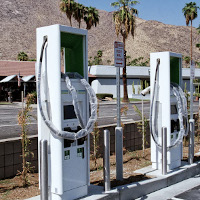
California’s Electric Vehicle Future
/ Paloma BeltranView the page for this story
In the wake of climate-fueled fire disasters, California Governor Gavin Newsom recently signed an executive order to ban the sale of new gas-powered vehicles by the year 2035. Living on Earth's Paloma Beltran reports on how switching to electric vehicles helps put the California economy on a path to full decarbonization by 2045. (04:29)
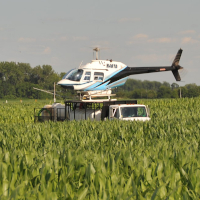
EPA Devalues Science To Downplay Chemical Risk
View the page for this story
The latest EPA action to further ignore sound science is its new assessment of the health risks associated with the pesticide chlorpyrifos. Epidemiological studies have found that children exposed to chlorpyrifos in utero suffer brain damage. But as pediatrician and epidemiologist Dr. Philip Landrigan tells Host Bobby Bascomb, the EPA is claiming that data is “inconclusive” because it protects the privacy of study participants. (09:37)
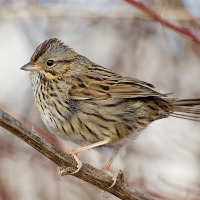
BirdNote®: October Migrants
/ Michael SteinView the page for this story
For many birds, October is a month of migration and movement, as birds of all kinds in the Northern Hemisphere make their way south. BirdNote®'s Michael Stein shares some notable species to keep an eye, and ear, out for this month. (01:52)
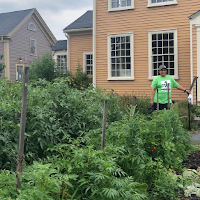
Urban Farming During COVID
/ Bruce GellermanView the page for this story
Boston, Massachusetts is home to the United States' oldest, continually-operated Victory Garden, made up of some 500 small plots dating back to World War Two. Today, urban farms throughout the city provide much needed nourishment for the city's residents, but the COVID-19 crisis changed the way these small farms operate. WBUR's Bruce Gellerman reports. (06:57)
Show Credits and Funders
Show Transcript
201016 Transcript
HOSTS: Bobby Bascomb, Steve Curwood
GUESTS: Joe Aldy, Georgina Gustin, Philip Landrigan
REPORTERS: Paloma Beltran, Peter Dykstra, Bruce Gellerman, Don Lyman
[THEME]
CURWOOD: From PRX – this is Living On Earth.
[THEME]
CURWOOD: I’m Steve Curwood.
BASCOMB: And I’m Bobby Bascomb
China pledges to be carbon neutral by 2060 and by ignoring climate change the US is losing its competitive advantage.
ALDY: We need the United States to be a key player because we have the resources, we have the scientists, we have the engineers, a lot of the technological innovation we need to get the world, eventually, to net zero.
CURWOOD: Also, new procedures at the EPA make it harder to show some chemicals are dangerous to human health.
LANDRIGAN: For EPA to break with the practice of the last 30 or 40 years and dismiss human epidemiologic studies because the investigators cannot give up the names of individual patients, it's really, very ridiculous. It represents a fundamental on the integrity of science.
CURWOOD: That and more this week on Living on Earth – Stick Around!
[NEWSBREAK MUSIC: Boards Of Canada “Zoetrope” from “In A Beautiful Place Out In The Country” (Warp Records 2000)]
[THEME]
Prairie Senate Races Show Climate Divide
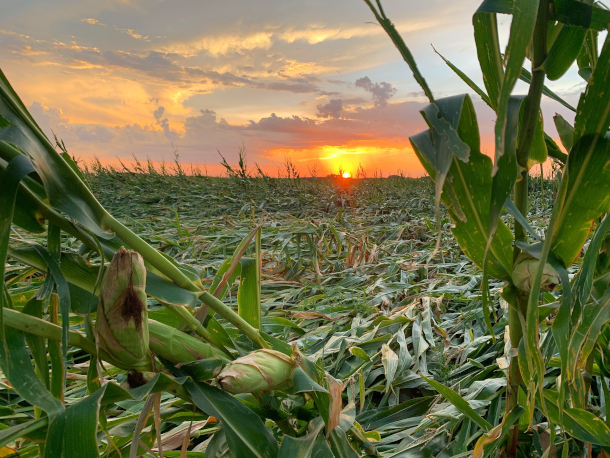
The sun sets over an Iowa cornfield flattened by the high winds of the August 2020 Midwest derecho storm. Climate change is bringing increasingly damaging storms and extreme weather to the Midwest. (Photo: Lisa Schmitz, National Weather Service, public domain)
CURWOOD: From PRX and the Jennifer and Ted Stanley Studios at the University of Massachusetts Boston, this is Living on Earth. I’m Steve Curwood.
BASCOMB: And I’m Bobby Bascomb.
We continue our Senate election coverage this week with two key races in the Midwest. Iowa’s seat is hotly contested. And in Kansas, which has not had a Democratic Senator since 1939, polls show the race is tighter than it has been in decades. Extreme heat, floods, and droughts are among the climate impacts that residents and farmers who drive the Midwest economy have to contend with. For more, I’m joined now by Georgina Gustin, a reporter for InsideClimate News who has been following the Iowa and Kansas Senate races. Welcome to Living on Earth!
GUSTIN: Thanks for having me.
BASCOMB: So first of all, Georgina, what kinds of climate impacts are facing voters in Kansas and Iowa?
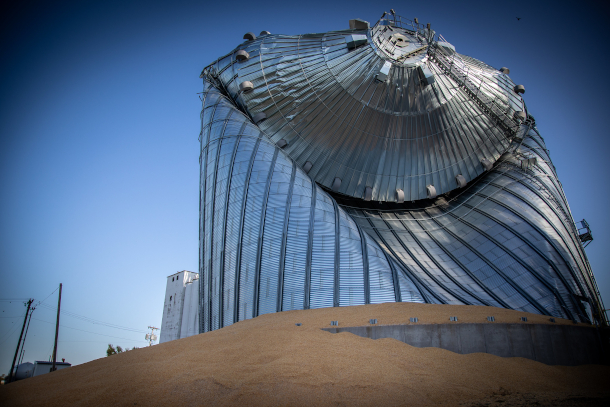
A grain silo in eastern Iowa twists and crumples in the wake of the August 2020 derecho, spilling thousands of bushels of corn. (Photo: Phil Roeder, Flickr CC BY 2.0)
GUSTIN: This year, Iowa saw a series of really weird, flukish storms in August, and there was pretty bad flooding and drought last year. And it's really over the course of the last several years that both states have been seeing the climate impacts on the ground. And I think what was an abstraction for a lot of farmers has become very real. And experts have projected that climate change would impact those states and the crops in particular for a long time. And going forward, they're going to have reduced yields of their major crops, which are obviously very important to both states. That's what the scientists are saying. But I think the reality in these last couple of years with these very extreme events, has made climate change part of the conversation there in a way that it hasn't been in the past.
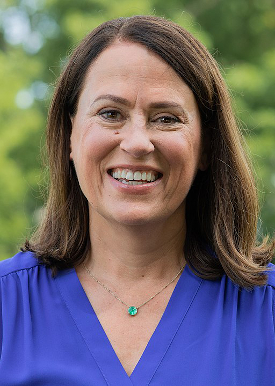
Democratic candidate for U.S. Senator Theresa Greenfield has made Social Security the centerpiece of her campaign and says climate change is threatening the Iowa economy. (Photo: Theresa Greenfield, Wikimedia Commons CC 1.0)
BASCOMB: Well, let's dig into the races a little bit. Let's start with the Iowa Senate race, where incumbent Republican Joni Ernst is facing a tough race against Democrat Theresa Greenfield. What is notable about how each of the candidates talk about climate and the environment?
GUSTIN: Well, both Greenfield and Ernst grew up on farms. And so they have that in common. And I think that's a really important characteristic for Iowa voters, because they can relate to that, and it feels very much of the state. It's obviously a heavy agricultural state and that shared background is, is important. Ernst is very clearly a climate denier. She has said she does not believe that climate change is human caused. And so her position is very clear. Theresa Greenfield has said that she believes climate change is affecting Iowa, particularly its farmers. But she has not been super specific with her climate policies. And she has, for example, not been clear about whether she supports the Green New Deal, and other climate-related policies. So she has to tread kind of a fine line there.
BASCOMB: That seems to be the moderate Democrat approach to this, generally. Now I understand that Ernst has a 1% League of Conservation Voters score, meaning that she's voted in favor of the environment, or at least as LCV sees it, only 1% of the time. That's a pretty bad record for the environment, you almost have to be trying to get that low of a score.

Senator Joni Ernst of Iowa has said she doesn’t believe that human-caused emissions are fueling a warmer atmosphere and increasingly destructive Midwestern storms. (Photo: U.S. Embassy Kyiv Ukraine, Flickr CC BY-ND 2.0)
GUSTIN: Yeah, she has a terrible score with the League of Conservation Voters, I think it might be the worst or among the worst, certainly. And she's in a bit of a situation in Iowa, because she has to, she's a supporter of ethanol, which is just central to the state's farmers and the state's economy. But she has also been very supportive of the oil and gas industry, which has been very supportive of her. And the oil and gas industry and the ethanol industries are at odds with each other because the oil and gas industry doesn't want to have to blend corn ethanol into fuel. And I think she's really lost ground with some farmers because she has supported the Trump administration's granting of waivers to oil and gas refineries that exempt them from blending a certain amount of ethanol into the fuel supply. That means less demand, potentially, for ethanol. So it's a very tricky issue for this administration, it's a tricky issue for Ernst, and she could lose ground. Because, of course, in Iowa, corn is king; if you do anything to tamp demand for corn, you could be losing some votes.
BASCOMB: Well, let's talk about the Kansas race now. Republican Senator Pat Roberts is retiring and leaving a vacant seat there. How are Republican candidate Roger Marshall and Democrat Barbara Bollier talking about climate change and the environment?
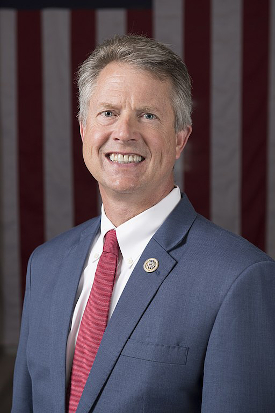
Congressman Roger Marshall, the Republican nominee for U.S. Senator from Kansas, is a climate skeptic and has regularly ignored CDC guidance on mask-wearing and social distancing during the COVID-19 pandemic. (Photo: Eric Connolly, U.S. House Office of Photography, public domain)
GUSTIN: Barbara Bollier believes that climate change is real and human caused. And Roger Marshall has said that he believes that it is part of a natural variation, and questions whether human activity has caused climate change. So again, it's a really partisan, almost predictable position from both candidates. And again, they are not super clear on their climate policies. Bollier has said that she does not support the Green New Deal. And her policy proposals on climate are pretty vague.
BASCOMB: Now I understand that both these candidates are actually medical doctors and actually went to the same medical school, even, but they have a very different approach here.
GUSTIN: Yeah, it's a really interesting factoid, I guess. They both went to the same medical school, as you say. They're both practicing doctors. They're both people of science. And yet on climate change, Marshall seems to be abandoning science for partisan position. And he's done the same with the coronavirus. He has not worn masks at many public events that he's had, whereas Bollier has held virtual events and always wears a mask when she does public events.
BASCOMB: Well, Georgina, what do you think the Iowa and Kansas races have in common in the ways that the candidates are talking or, you know, maybe not talking about climate change?
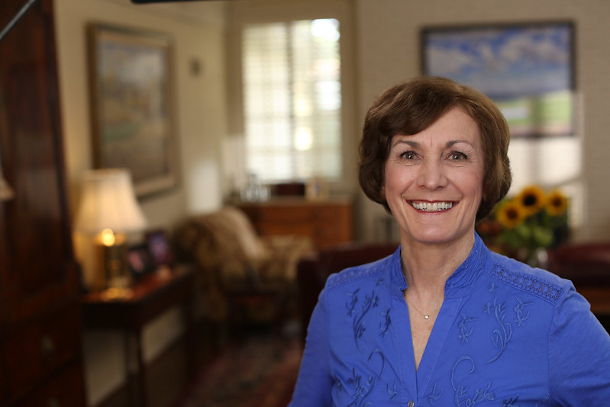
Barbara Bollier, the Democratic nominee for U.S. Senator from Kansas, is currently a member of the Kansas state Senate who left the Republican Party in 2018. (Photo: Barbara Bollier, Flickr CC BY-SA 2.0)
GUSTIN: I think both of these races really illustrate how climate change has become such a partisan issue, and how science has become so politicized under the Trump administration, in particular. You have two doctors with identical backgrounds in terms of their academic training, taking two very different positions on climate, taking two very different positions on COVID-19. And in Iowa, you have an oil and gas senator, you know, potentially losing ground because of her support for that industry. But that might not really sway voters in a sort of outcome changing way. Joni Ernst is very much a climate denier, she maintains that position, and for people that are dug in on that issue, I don't know that their minds will be changed.
BASCOMB: Georgina Gustin is a reporter for InsideClimate News. Georgina, thanks so much for taking this time with me today.
GUSTIN: Thank you.
Related links:
- InsideClimate News | “Senate 2020: Iowa Farmers are Feeling the Effects of Climate Change. That Could Make Things Harder for Joni Ernst”
- InsideClimate News | “Senate 2020: In Kansas, a Democratic Climate Hawk Closes in on a Republican Climate Skeptic”
[MUSIC: Joel Mabus, “Grand Old Rag” on Parlor Guitar, by George M. Cohan, Fossil Records]
Beyond the Headlines
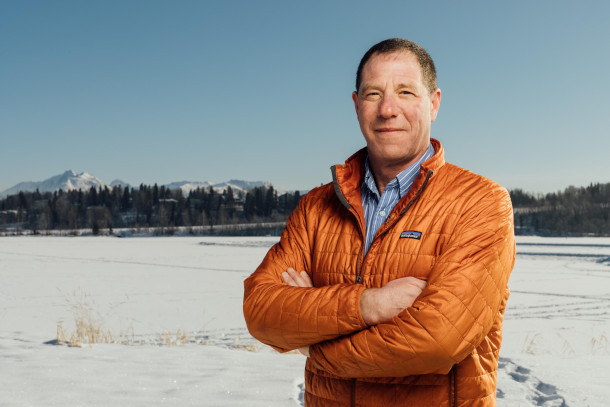
Dr. Al Gross is the independent challenger in this year’s Senate race in Alaska. He’s an orthopedic surgeon with ties to the salmon fishery as a teenager and has been outspoken about climate change and his opposition to the Pebble Mine. (Photo: Courtesy of the Al Gross Campaign)
CURWOOD: We continue our look at US senate races now with Peter Dykstra. Peter is an editor with Environmental health news …that’s ehn.org and daily climate dot org. He’s on the line now from Atlanta. So, hi there Peter, what do you have about the senate in your weekly roundup of stories beyond the headlines?
DYKSTRA: Well, hi, Steve. There's a race in Alaska that was a snoozer, and all of a sudden could not only be a race that could help turn the senate from Republican control to the Democrats. But the issue that it all turns on, could be an environmental scandal, never seen that before.
CURWOOD: Wow, so tell me what's the story?
DYKSTRA: GOP Senator Dan Sullivan. First termer, thought to cruise to re election, all of a sudden, thanks to a scandal over the controversial Pebble Mine a huge mining project that could threaten the Bristol Bay fishery, is getting a serious challenge, neck and neck with an independent, Dr. Al Gross. He's an orthopedic surgeon, who was a lifelong Alaskan, was a salmon fishermen at age 14 till he left for college and med school. Now he's back, and he's back in part to defend Bristol Bay, and to take action on climate change.
CURWOOD: And just how important is Bristol Bay to the salmon fishery?
DYKSTRA: Bristol Bay is the largest sockeye salmon fishery in the world. It's considered the most productive fishery of any kind within the US. And it's at the heart and soul, not just economically but also culturally, to Alaska, fishing being arguably the second biggest contributor to the Alaskan economy after oil and gas.

Incumbent GOP Senator Dan Sullivan is still favored to win his matchup in this year’s Senate race in Alaska, but he’s facing a stiff challenge in part because of ties to the Pebble Mine project, which is unpopular in Alaska. (Photo: US Congress, Public Domain)
CURWOOD: And what's the relationship of Senator Dan Sullivan to this?
DYKSTRA: Recent report linked Sullivan to campaign contributions from supporters and investors in the mine. There was also an audio recording by some of the mining officials talking about how they could help Sullivan win. And it's a tight race. If Sullivan loses, the republicans are that much closer to losing control of the Senate.
CURWOOD: Interesting. Well, we'll be watching that closely. Hey, what else do you have for us today?
DYKSTRA: Remember the murder Hornets? They were the year 2020 candidate for creepy, scary invasive species?
CURWOOD: Oh, yeah, these are big things. They're supposed to be a couple inches long, right?
DYKSTRA: A couple inches long, which means maybe five times as long as other bee species we have in the US and they are a real threat to other bee species. They're known to destroy entire hives. And also they're apparently very good at decapitating other bees, attention Stephen King and other script writers out there. Murder Hornets are apparently not going to kill people. But their threat to other native bee populations is for real, and evidence of it is beginning to turn up in places like Washington State.
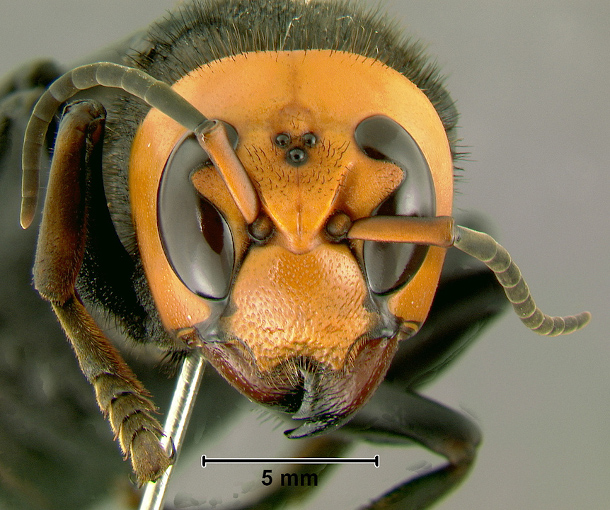
Vespa mandarinia, a giant hornet native to east Asia, is one of many invasive species that has taken advantage of the way that humans move goods around the planet, possibly by hitching a ride. (Photo: Gary Alpert, Wikimedia Commons, CC BY 2.5)
CURWOOD: Well, America, of course has this fabulous history of scary invasive species stories that don't turn out to be quite as scary. I'm thinking of the killer bees for one.
DYKSTRA: The killer bees. 45 years ago, they were an epic Saturday Night Live skit, these aggressive bees have made some inroads in the far southern US, but they're not exactly taking over which was what our original fear was, the murder Hornets. However, there's at least a chance they could be a real threat.
CURWOOD: Hey, Peter, what do you have from the annals of history for us today?
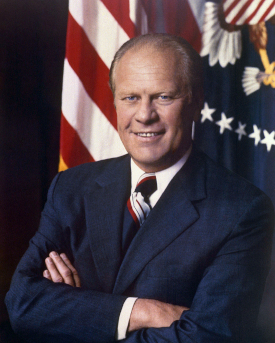
President Gerald R. Ford was the one to sign the Toxic Substances Control Act (TSCA) into law in 1976. (Photo: David Hume Kennerly, National Archives and Records Administration, Public Domain)
DYKSTRA: October 21 1975 a 45th anniversary for both houses of Congress passing the Toxic Substances Control Act, known by the operatic acronym of TOSCA. It tightened rules on the production and use and export of toxic chemicals. And for the first time allowed EPA and other agencies to look at chemicals and other substances previously in use, and therefore legally assumed to be safe. There were various uses of lead, and pesticides that were all of a sudden, under regulation, where regulation had passed them by, it was a game changer for taking many threats to public health in the environment, putting them back in play, and making our world a little safer.
CURWOOD: All right, Peter, thank you.
DYKSTRA: And before I go, Steve, one more thing. We have a diligent listener from this past week, who caught that I had muffed the date of a coalway spill into the Big Sandy river, that happened in 2000. The year 2000. So thanks to one of our diligent listeners for pointing that out.
CURWOOD: Peter Dykstra is an editor with environmental health news at EHN.org and daily climate.org. We'll talk to you again real soon. Thanks, Peter.
DYKSTRA: All right, Steve, thanks a lot. Talk to you soon.
CURWOOD: And there's more on these stories in the living on earth website. LOE.org
Related links:
- Read more about the controversy surrounding Senator Dan Sullivan and the Pebble Mine in Alaska
- Click here to learn why the Giant Hornet (Vespa mandarinia) which has been sighted for the first time in Washington State this year, may pose a threat to honeybees this fall
- Click here to read a story which attempts to put the ‘Murder Hornets’ in their entomological context
[MUSIC: Bela Fleck and the Flecktones, “The Sinister Minister” on Bela Fleck and the Flecktones, by Bela Fleck, Warner Bros]
BASCOMB: Coming up – The Governor of California is banning the sale of new gas and diesel powered vehicles by 2035. That’s just ahead here on Living on Earth.
ANNOUNCER: Support for Living on Earth comes from Sailors for the Sea and Oceana. Helping boaters race clean, sail green and protect the seas they love. More information at sailors for the sea dot org.
[CUTAWAY MUSIC: Bela Fleck and the Flecktones, “The Sinister Minister” on Bela Fleck and the Flecktones, by Bela Fleck, Warner Bros]
Note on Emerging Science: Puffins Use Tools
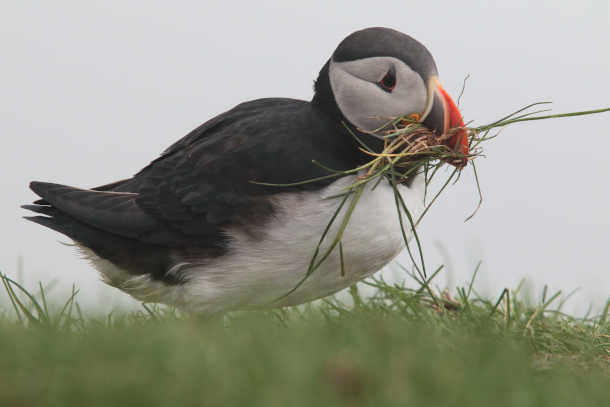
A puffin plucks blades of grass to carry to its nest. (Photo: Tomek Niedzwiedz, Flickr, Public Domain)
CURWOOD: It’s Living on Earth, I’m Steve Curwood.
BASCOMB: And I’m Bobby Bascomb just ahead, progress on tackling climate change from China and California but first this note on emerging science from Don Lyman.
[SCIENCE NOTE THEME]
LYMAN: For the first time, scientists have documented the use of tools by puffins, a black and white seabird found in the North Atlantic. Annette Fayet, an ecologist from the University of Oxford, first observed a puffin off the coast of Wales using a stick to scratch its back in 2014. Four years later, on Grimsey Island in Iceland, Dr. Fayet’s recorded a puffin picking up a stick and using the stick to scratch its chest feathers. The observations were published in the Proceedings of the National Academy of Sciences. Researchers said they are the only known examples of birds in the wild using tools to scratch themselves.
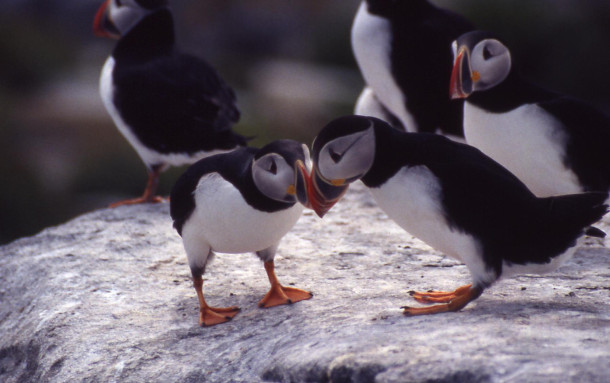
Atlantic puffins touch bills as a part of a courtship ritual. (Photo: U.S. Fish and Wildlife Service, Flickr, Public Domain)
The scientists speculate that the puffins may have been trying to remove ticks from their feathers, as ticks are a common parasite in puffins. Scientists have known for some time that other birds use tools. Crows use sticks to extract food from holes in logs and Egyptian vultures crack ostrich eggs open with rocks. But this is the first known case of seabirds using tools. The researchers said that the discovery in puffins suggests that tool use in birds may be more widespread than previously thought. That’s this week’s note on emerging science. I’m Don Lyman.
Related links:
- Find out more about Dr. Fayet’s research on her website
- ZME Science | “Puffins Are Now Using Tools – And It’s Making Them Feel Much Better”
- PNAS.org | “Evidence of Tool Use in a Seabird”
- AAAS | “Watch a Puffin Use a Tool – To Scratch an Itch”
- JSTOR Daily | “Puffins Seen Using Tools, Breaking Dumb-Puffin Stereotypes”
[SCIENCE NOTE THEME]
China Leads on Climate
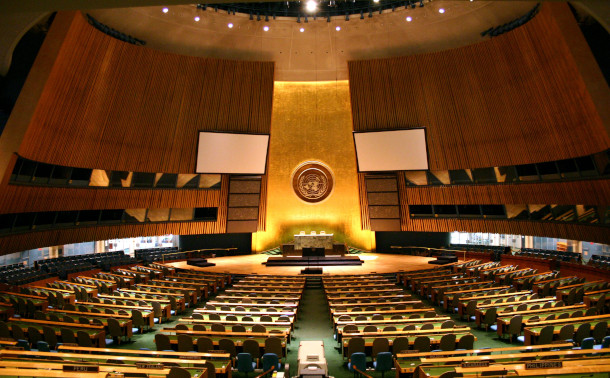
China‘s President Xi Jinping spoke to the UN General Assembly through video in 2020. (Photo: Patrick Gruban, Flickr, CC BY-SA 2.0)
CURWOOD: China has taken the lead in global climate change politics. In front of world leaders at the annual UN general assembly gathering President Xi of China pledged his nation would peak its carbon emissions before 2030, and reach net zero emissions by 2060. These commitments come in response to the Paris Climate Agreement. As the world’s largest single contributor to greenhouse gas emissions China’s move is the most significant so far under the pact, giving it a competitive and political edge as the US remains on the sidelines of the international climate pact. Joe Aldy is an economist and Professor of Public Policy at Harvard’s Kennedy School, and he joins us now. Joe, welcome back to Living on Earth!
ALDY: Steve, it's a pleasure to be here. Thanks for having me.
CURWOOD: So, if I look at the math, I think that China's responsible for about 28% of global carbon dioxide emissions these days. Put that in context for us, how important is it for them to make a commitment of reduction?
ALDY: Well, the challenge we face with climate change is that globally, greenhouse gas emissions have been increasing just about every year for the last four decades. This year, because of COVID, we'll see, I think globally, emissions fall. But China's emissions have been the fastest growing, especially over the past two decades. It was just a little bit more than a decade ago that China passed the US in terms of annual emissions. Now, China's emissions are double what they are in the United States. So if we are going to be up to, as a planet, the challenge of combating climate change, and avoiding some of the most catastrophic impacts of climate change, China has to be a critical player and changing its trajectory and dramatically lowering its emissions over time.
CURWOOD: What does carbon neutrality mean? And what do you think the Chinese mean by it?
ALDY: So, I don't know what the Chinese mean by carbon neutrality. We hear a couple different terms like this, like carbon neutral, or net zero, we hear this from countries, we hear this from companies. Carbon neutrality might mean that they are going to reduce their emissions as much as possible. And then to an extent, they still have some emissions, coming out of their plants, or their cars, or what have you. They may be investing in projects that will pull carbon dioxide out of the air, maybe it's planting trees, maybe doing things in another country, maybe investing in direct air capture technology, that captures the CO2 out of the air and puts it underground. So, that may be what they mean, but the President wasn't all that specific about it. And I think, you know, this is another illustration about the devils in the details.
CURWOOD: What do you think was China's strategy with making this pledge, this announcement, now?
ALDY: Well, I think there's a few audiences that the Chinese government have in mind. Certainly they made this announcement in New York, at the opening of the UN General Assembly, so they were trying to speak to the whole world, the international community. I think part of this is an effort to try to rebuild his reputation, because of how poorly they handled COVID-19 at the beginning of the year, and it truly took a horrific toll that's played across the planet. So, I think they recognize that climate change is an area where if they can demonstrate leadership, they can try to rebuild a relationship with other countries around the world and demonstrate their willingness to coordinate and cooperate on a pressing global risk, like climate change. I think they're also speaking to the United States. Now we've got incredible uncertainty about where US climate policy is going to go because of what's going to happen in November with our presidential election. If President Trump is reelected, I think it's trying to then further put the Trump administration in a corner as an isolationist because of their hostility to climate change. But I think they also recognize that if there's a President Elect Biden, you're going to see a United States government, that's going to be much more ambitious tackling climate change. You're going to see a new US government come out and say, here's what we're going to do in the near term to reduce our emissions. Here's our plan to go to net zero by 2050. And I think this is a way to try to anticipate the kind of pressure they would likely get from a Biden administration to lead on this. I think the third audience is their domestic audience, Steve.
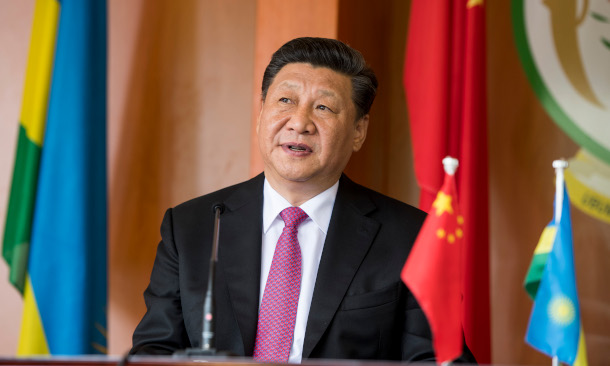
President Xi Jinping’s statement is the first public declaration of China of their intent to reach carbon neutrality. (Photo: Paul Kagame, Flickr, CC BY-NC-ND 2.0)
CURWOOD: Mm hmm.
ALDY: And and I think part of is they're getting ready for the next five year plan. And that sort of sets forth policy that's going to drive their economy. And I think this is one way for Xi to go back to Beijing and say, we've made this commitment to the rest of the world, we need to actually start crafting our domestic policies to try to deliver on this.
CURWOOD: Now, some criticize this announcement from China as being too little too late. And others say it's unlikely China's actually going to, at the end of the day, step up to the challenge. What are your concerns about this pledge?
ALDY: Well, it is a bit ambiguous. So they're not telling us at what level their emissions are going to peak. They're not even really telling us what year their emissions are going to peak, they're just going to say they're going to peak before 2030. And that has implications about how credible the long term goal of carbon neutrality by 2060 is. But I think all this is a reflection that you can make these announcements in the international sphere. But you've got to demonstrate their credibility by the kinds of policies you put in place domestically. And so that's why it's going to be really important to see what Beijing comes forward with over the coming months and in 2021, in terms of domestic policy coming out of Beijing, as well as what we see even at the provincial level, and what they do to try to reduce their emissions by driving more renewable power, reducing their reliance on coal, despite the fact they're still building coal-fired power plants. So there is some tension here, I think between their economic strategy and what they need to do to deliver on this, but I think the real proof is going to be in the domestic program they develop over the next year.
CURWOOD: How expected was it that China would move ahead regardless of the US pulling out of or in the stages of pulling out of the Paris Climate Agreement?
ALDY: So I think it's interesting to see China doing this. They had been historically, over the past decade, a little, if you will, reluctant to make pledges in the international negotiations. So in the run up to the 2009 Copenhagen talks, they talked about how they would reduce the carbon intensity of their GDP by 2020. But it took a lot of personal negotiation by President Obama himself, to get them to commit to making that part of the Copenhagen Accord, which is the first time they ever made any kind of mitigation pledge in the international negotiations. Here, what we're seeing is actually, I think, one of the true strengths of the Paris framework, where countries would regularly pledge what they're going to do, review their pledges, and then update, revise and enhance those pledges. And so part of the negotiating process now, isn't really do we negotiate a new agreement? It's how do we update what we say we're going to do to reduce their emissions and in the lead up to next year, because of COVID, we've delayed the UN climate talks one year, but in November of 2021, the UN climate talks will meet in the UK and focus on what countries have done to enhance and revise their pledges. And so China is one of the first countries out of the gate, saying, here's how we can do more than what we previously pledged. So I think it's a positive sign for how the Paris framework works. And it may be just as important whether or not it galvanizes action by other developing countries to step up to the plate, and increase the ambition of their pledges, as much as how much we count the tons that will be reduced in China because of what they're saying they're going to do.
CURWOOD: For people who are really concerned about the climate crisis, what consequences do you hope this move will have for global climate policy? And how real of an advance is this as opposed to posturing?
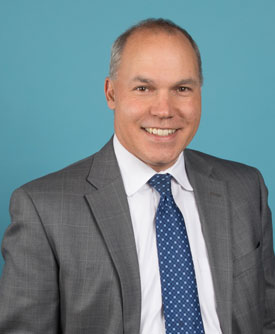
Joe Aldy is an economist and professor of public policy at Harvard’s Kennedy School. (Photo: Courtesy of Joe Aldy)
ALDY: So the potential here is quite significant. Some scholars in Europe at the Climate Action Tracker, they estimate that if China actually delivers on carbon neutrality by 2060, it probably reduces warming in this century by two to three tenths of a degree Celsius. Which is actually quite substantial when that's just one country's actions. It's by far the largest single commitment to reducing warming that they've seen among any country that has made a pledge under the Paris framework. The challenge is all we have right now are a near term goal that's ambiguous and a 2060 goal on carbon neutrality that's a little bit ambiguous, because we really don't know what they mean by carbon neutrality. I think if they're able to sort of demonstrate through domestic policy actions, that they're really serious about this, I think that matters. I think it matters, too, to just have the head of state speaking about this issue. That signals I think, the seriousness. I think the EU, which has long been a leader on climate change, or say the small island states that have long been a vocal proponent for ambitious climate change, when they look at the US and China, they don't see the leaders speaking about climate change that much. So I think it does give them a little bit more reassurance that China is serious about this. So what I'm hopeful about is that this gets the attention of other countries around the world, that maybe is a first step towards rebuilding the US-China relationship that was so critical, late in the Obama administration, leading up to the Paris conference of 2015, That hopefully this gets us moving and moving faster and faster going forward. And that's where you can see and be optimistic about this. But you know, as an economist, I like to see the evidence, I like to see the policies that they're going to implement. So, I'm going to look to see what they came up with their five year plan and how they're going to be driving more clean energy investment in their economy going forward.
CURWOOD: China's step forward here certainly puts US leadership in question. But can the world survive the climate crisis without the United States moving forward in much more of a leadership role, Joe?
ALDY: No, the world needs the United States, there's no doubt about that. We need the United States to be a key player, because we have the resources. We have the scientists, we have the engineers. A lot of the technological innovation we need to get the world eventually to net zero is going to come out of the creativity in the entrepreneurship, and even scientists that are government labs all working together to tackle this problem. I can't imagine that the world can solve this problem without the United States. We saw that with Kyoto, when the United States didn't participate, global emissions continue to increase. We need the US involved. We need China involved. At the end of the day, we're going to need everybody involved. But we're going to need the biggest countries, the biggest sources of emissions, and the ones with the greatest resources to be at the forefront leading the global effort to combat climate change.
CURWOOD: Joe Aldy is a Professor of Public Policy at Harvard's Kennedy School. Joe, thanks so much for taking the time with us today.
ALDY: Well, thank you, Steve. I've enjoyed it.
Related link:
Climate Home News | “Xi Jinping: China Will Aim for Carbon Neutrality by 2060”
[MUSIC: Yungchen Lhamo, “Happiness Is…” on Gardens of Eden, by Yungchen Lhamo, Putumayo]
California’s Electric Vehicle Future
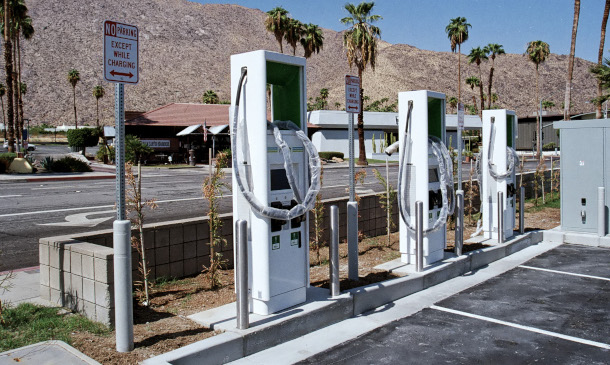
California has approximately 22,000 charging stations and 665,000 electric vehicles on the road. (Photo: Ron Gilbert, Flickr, CC BY ND 2.0)
BASCOMB: With little to no action on climate change the current federal government, states have stepped in to fill the gap and a leader is California. In 1990 the California Air Resources Board (CARB) created the zero emissions vehicle program, aimed at combatting the state’s poor air quality. It required the seven automakers in the US at that time to produce and sell zero emission vehicles or ZEVs. In 1996 General Motors designed an electric vehicle called “impact” or the GM EV-1. It was the first electric vehicle meant for mass production but both the California rule and the small two seater did not last. GM literally crushed every EV-1they made, fearing it would spark a turn away from their money making gasoline cars. Fast track to now and California rules for Zero Emission Vehicles are back. Living on Earth’s Paloma Beltran has this story.
BELTRAN: California has experienced an unprecedented wildfire season this year and climate scientists are telling the state to brace for even more extreme fires in the future.
For California to do it’s part to address climate change and reduce carbon emissions Governor Gavin Newsom recently signed an executive order banning the sale of new combustion powered vehicles by the year 2035.
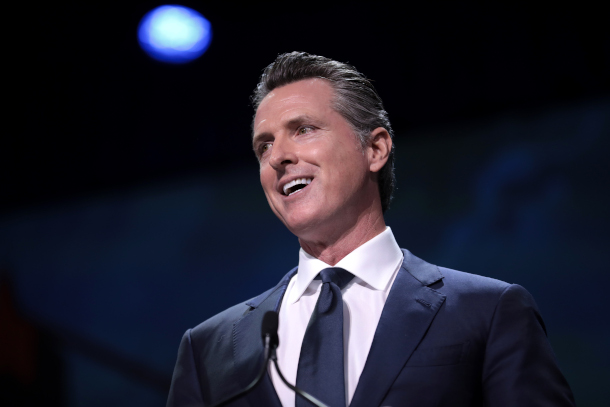
Governor Gavin Newsom has ordered the phase out of the sale of new gas-powered vehicles by the year 2035 to fight climate change. (Photo: Gage Skidmore, Flickr, CC BY SA 2.0)
NEWSOM: We believe America is coming to traction, not just in terms of the impacts of climate change, but our resolve to address the impacts of climate change, and so I couldn't be more proud today, to be able to sign this executive order.
BELTRAN: To be clear the order will affect only the sale of new vehicles.
Proponents are optimistic that the Electric Vehicle plan will help California meet its climate goals and create an economic boom in the process.
Although California is home to several zero emission manufacturers fewer than 2% of cars registered in California produce zero emissions.
Today electric vehicles tend to be more expensive than gas and diesel. So some Californians worry that this order will make new cars too expensive.
But Jared Blumenfeld California’s Secretary for Environmental Protection says it still makes financial sense to own an electric vehicle.
BLUMENFELD:So on average owning an electric vehicle is lower maintenance, and you don't need any gasoline. So it saves me about four and a half thousand dollars a year than it would a gas powered car. So this is about choice. We want to give people a choice so that you don't have to choose between a dirty vehicle and a clean vehicle because of cost.
BELTRAN: Another advantage is that EV’s are more efficient at converting energy into motion.
And they can be charged at night when base load power might otherwise be wasted.
And there is the possibility that electric vehicles could sometimes serve as assets for the electric grid, with their batteries tapped during periods of peak load demand.
But timing is everything and a major shift to EVs charge up during the day could require an increase in electric power production.

The 1996 General Motors V1 was an electic car available in California for lease. It was expected to be the future of electric vehicles, but General Motors removed the car from the market. (Photo: Joe Ross, Flickr, CC BY SA 2.0)
Transportation accounts for about half of California’s air emissions and the fossil fuel vehicle ban is expected to cut 35% of that, lowering the state’s greenhouse gas emissions and also improving it’s notorious air quality.
About a third of the energy used for the electric grid in California comes from natural gas..
So Food and Water Action Director Alexandra Nagy believes transitioning away from gasoline and diesel powered vehicles is not enough..
NAGY: The vehicles that are still burning electricity at that point, are not guaranteed to be clean, because we still burn a lot of fracked gas here in California to power our lights and our energy infrastructure and cars are no exceptions. So we need to make sure that as we're transitioning to clean technology that it is in fact being powered by clean energy.
BELTRAN: Currently about a third of California’s electricity comes from renewable energy sources such as solar wind and hydro.
But the Newsom administration is planning to double renewable energy in the years ahead, and put the state on course to fully decarbonize by 2045.
For Living on Earth I am Paloma Beltran
Related links:
- New York Times | “California Plans to Ban Sales of New Gas Powered Cars in 15 Years”
- Politico California | “Newsom Bans New Gas Cars”
[MUSIC: Woody Guthrie, “Car Song” on Car Song, by Woody Guthrie, Asch Recordings]
CURWOOD: Coming up – Urban farming takes on new importance and challenges during the pandemic. That’s just ahead on Living on Earth.
ANNOUNCER: Funding for Living on Earth comes from you, our listeners, and United Technologies, combining passion for science with engineering to create solutions designed for sustainability in aerospace, building industries, and food refrigeration.
[CUTAWAY MUSIC: Earl Hines, “Mack the Knife” on Tour de Force, by Weill, Brecht & Blitzstein, 1201 Music]
EPA Devalues Science To Downplay Chemical Risk
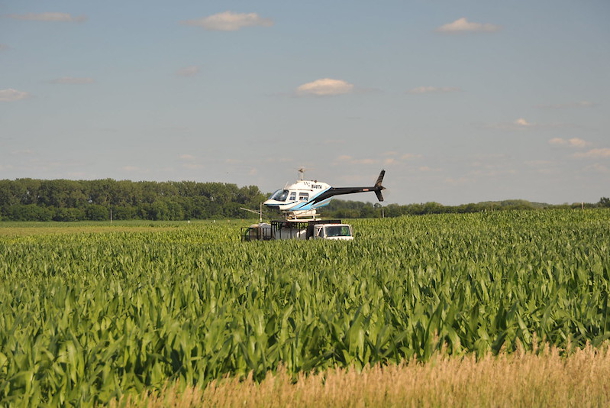
In an Iowa cornfield, a crop-dusting helicopter refills its pesticide tanks. (Photo: Carl Wycoff, Flickr CC BY 2.0)
CURWOOD: It’s Living on Earth, I’m Steve Curwood.
BASCOMB: And I’m Bobby Bascomb.
Solid science is fundamental to the Environmental Protection Agency’s ability to protect Americans’ health. But increasingly under the Trump administration the agency is ignoring scientific evidence as it studies risk and sets guidelines, for everything from greenhouse gas emissions to toxic pesticides. The latest EPA action to draw outrage from concerned scientists is its updated assessment of the health risks associated with chlorpyrifos, a widely-used pesticide that attacks the nervous systems of insects. Epidemiological studies have found that children exposed to chlorpyrifos in utero suffer brain damage. And exposure is easy to come by especially for farm workers and for mothers who eat produce with pesticide residue on it. Yet despite the evidence, the latest EPA assessment of chlorpyrifos finds that the data showing human health harm is “inconclusive” because scientists, citing privacy rights, will not release the names of study participants. Here to discuss is Philip Landrigan, a pediatrician and epidemiologist who directs the Global Observatory on Pollution and Health at Boston College. Welcome back to Living on Earth!
LANDRIGAN: Bobby, it's great to be here. Thank you for inviting me.
BASCOMB: Well, Dr. Landrigan, first off, will you please describe for us the studies that were conducted regarding the health impacts of chlorpyrifos? Who did those studies and what did they find?
LANDRIGAN: Well, researchers at three universities -- at the University of California at Berkeley, at Columbia University School of Public Health in New York City, and Mount Sinai School of Medicine in New York City -- decided that they would undertake what are called prospective, longitudinal epidemiologic studies. And these are studies where the goal is to determine whether exposure to chlorpyrifos causes damage to the developing brains of infants in their mother's womb. And the way they did these studies, each of the studies used the same basic design. They enrolled pregnant women early in pregnancy, they measured each woman's individual exposure to chlorpyrifos during her pregnancy in a couple of ways. First of all, they asked women about exposure to pesticides, and then secondly, they took urine samples at one or more points during pregnancy. And then after the babies were born, they did systematic exams, developmental exams, developmental testing on the babies, as they grew up. And they all three found that babies who are exposed in the womb to chlorpyrifos had evidence of brain and nerve damage after they were born. And specifically, what they found was reduction in IQ, some shortening of attention span, which increases the risk for attention deficit disorder, and some behavioral issues. And they found that the heavier a child's exposure, that is to say the higher the dose, the higher the level of chlorpyrifos in the mother's urine during pregnancy, the worse the damage. They also, when the children got old enough to do more sophisticated studies, they asked some of the children to take MRI studies of their brain. And they found that children who are exposed to chlorpyrifos have abnormalities in MRI that were not seen in unexposed children.
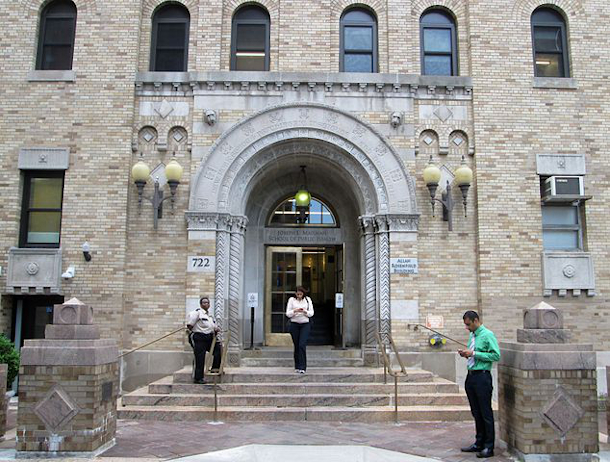
Columbia University’s Mailman School of Public Health, pictured above, conducted a key study that found a link between chlorpyrifos exposure and early childhood developmental delays. (Photo: Beyond My Ken, Wikimedia Commons CC BY-SA 4.0)
BASCOMB: Well, now the EPA is saying that the results of these studies are inconclusive. What's going on here? Why is EPA choosing to invalidate well-documented studies on a human health risk?
LANDRIGAN: Well, I think it begins with the fact that EPA decided, the EPA and this administration, decided very early on, back in 2017, that they were not going to ban chlorpyrifos. And then what they've had to do since that time, is to come up with a rationale that would explain the decision that they really already made, which in my opinion, was a decision that was based on politics, and also on protecting the commercial interests of the pesticide manufacturing companies. There's no other way to say it. They came up with this very clever idea, this very nice sounding way to dismiss studies, which they call "transparency in science". At first blush, that sounds like a good thing. I mean, transparency is good, isn't it, you know? But in this instance, it's not a good thing. And the reason it's not a good thing is that when doctors and nurses asked families to participate in studies, like these prospective studies of mothers and babies done at UCSF, Columbia, and Mount Sinai, they promised the families confidentiality. So the EPA people, these politically motivated folks at EPA, have seized upon this. And they say, "well, that's secret science. We can't use those studies if you won't reveal data on the individuals, you're not being transparent." They say, "you're operating in secrecy." But the investigators who did these three studies at Mount Sinai, at Columbia, at UC Berkeley, of course they provided all their information to the EPA, except personal identifiers, name, address, Social Security number. So EPA has everything that any rational person would need to draw conclusions. And so under this ruse, under this very clever ruse -- which incidentally, is a ruse that was first invented, I'm told, by lawyers for the tobacco industry who were trying to dismiss studies that linked smoking to lung cancer -- using this very clever ruse, they have said, "Okay, we're not going to count these three very well done human epidemiologic studies in rulemaking. We'll just have to make do without them. And we'll use whatever else is out there." Well, there are other studies out there. In fact, there are some excellent studies showing that if laboratory animals, rats and mice, are exposed to chlorpyrifos during pregnancy, the baby rats are born brain damaged as well. And that's important information, but still, for EPA to break with the practice of the last 30 or 40 years and dismiss human epidemiologic studies because the investigators cannot give up the names of individual patients, it's really, very ridiculous. And in my mind, it represents a fundamental assault by EPA and this administration on the integrity of science.
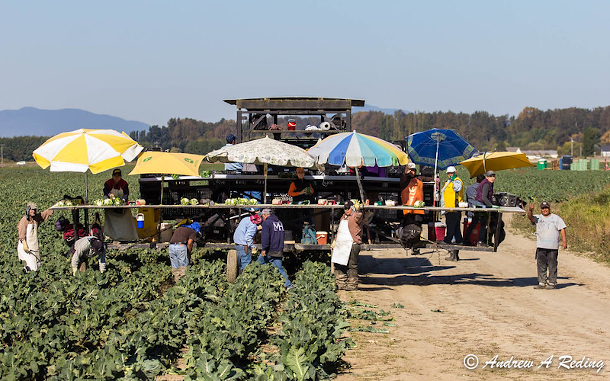
Farmworkers and their children are at especially high risk for health impacts linked to chlorpyrifos exposure, including brain damage and developmental delays. (Photo: Andrew Reding, Flickr CC BY-NC-ND 2.0)
BASCOMB: Well, how concerned are you about EPA adopting this "restricted science" policy in assessing the safety of many other chemicals, not just chlorpyrifos?
LANDRIGAN: Well, I'm very worried about that. I think the current leadership at EPA is using chlorpyrifos as a test case. And if they can get away with making this rule stick in the case of chlorpyrifos, then I have no doubt that they will apply it widely to the evaluation of many chemicals. And the net effect of all that is that restrictions on the use of a whole number of chemicals will be lifted. There are more than 80,000 synthetic chemicals licensed for use in the United States, licensed by EPA for use in the United States. And these chemicals are found in every single product you can imagine, from baby bottles, to blankets, to mattresses, to couches, to computers, to building materials. And as these chemicals get out of those materials, they get into us, they get into the environment, they contaminate the environment very widely. And in this country, we have a very weak, almost totally toothless system for screening chemicals for safety or toxicity before they come into market. We do a very good job in the United States of screening drugs. If a pharmaceutical manufacturer wants to bring out a new drug for high blood pressure, or heart disease or some other condition, the drug has to be meticulously screened and tested before it can be brought to market. But pesticides and consumer chemicals of all kinds, the kinds of chemicals that go into cosmetics and food wrapping and household furnishings and such, those chemicals are basically presumed to be innocent until proven guilty. And as a result, chemicals come on the market, people are exposed to them. And then sometimes years or even decades after these manufactured chemicals have been brought to the market, we learn that they can cause harm. So the chemical regulatory system in the United States is already broken. And then the current leadership of EPA is making this broken system even worse.
BASCOMB: That must be very frustrating for you as a physician to watch.
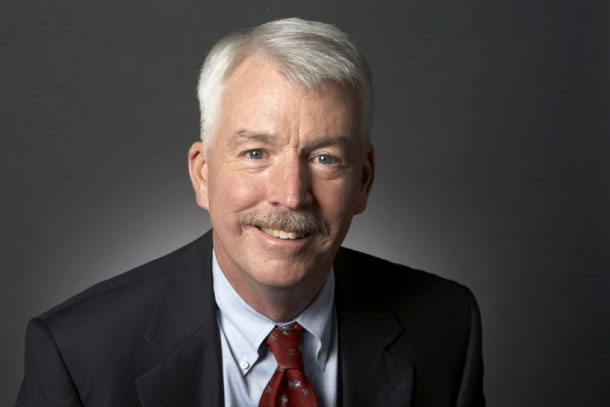
Philip Landrigan is the Founding Director of the Global Public Health Program and Global Pollution Observatory at Boston College (Photo Courtesy of Boston College)
LANDRIGAN: It's very frustrating for me as a physician; it bothers me intellectually that EPA should not follow good science. It bothers me as a citizen that in essence, EPA is breaking the law. But it bothers me even more as a pediatrician who cares for children. Because these regulations are not disembodied legal structures, far from it. Rules and regulations like rules on chemicals like chlorpyrifos have very direct consequences for children's health. And when our country allows young children and pregnant women to be exposed to a chemical that causes brain damage, babies are born with brain damage, as sure as night follows day. And that's what these folks at EPA are setting up.
BASCOMB: Dr. Philip Landrigan is a pediatrician and epidemiologist at the Global Observatory on Pollution and Health at Boston College. Dr. Landrigan, thank you so much for taking this time with me today.
LANDRIGAN: Bobby, thank you. It's been a pleasure.
BASCOMB: We reached out to EPA for a statement. Spokesperson James Hewitt replied via email and said, “EPA remains unable to verify the reported findings” of the studies in question.
Related links:
- NYTimes | “E.P.A. Rejects Its Own Findings That a Pesticide Harms Children’s Brains”
- InsideClimate News | “EPA’s ‘Secret Science’ Rule Meets with an Outpouring of Protest on Last Day for Public Comment”
- EPA info about the “Strengthening Transparency in Regulatory Science” rule
- Environmental Working Group | “How to Avoid Brain-Damaging Chlorpyrifos in Milk and Produce”
- About Dr. Phil Landrigan
[BIRDNOTE THEME]
BirdNote®: October Migrants
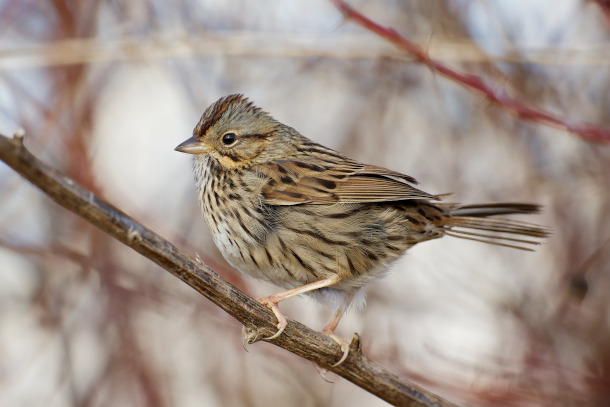
The Lincoln’s Sparrow is a small bird native to North America, known for its wrenlike sound. (Photo: © Gregg Thompson)
CURWOOD: Look up in the sky this time of year -- or better yet, listen up! -- and you’ll surely see and hear great flocks of birds on their long journeys south here in the Northern Hemisphere. BirdNote’s Michael Stein has more.
BirdNote®
October Migrants – Look Who’s Back!
[Lincoln’s Sparrow song]
The birds’ voices declare, in no uncertain terms, that autumn is once again upon us. In the golden sunlight of an October morning, a Lincoln’s Sparrow sings energetically from a hedgerow [Lincoln’s Sparrow song], and soon a Fox Sparrow chimes in [Fox Sparrow song].
Both nested at higher latitudes or well up in the mountains last summer, but will spend September to May at lower latitudes or elevation.
In October, massive movements of birds take place across the continent. The exodus of summer visitors to the tropics has given way to a surge from the north. The brambles twitch with sparrows [Call of Song Sparrow], blackbirds flock by the thousands. Bays and lakes sparkle with waterbirds — loons, grebes, dabbling and diving ducks. [Chatter of Mallards] Many of them nested well to the north, on tundra ponds.
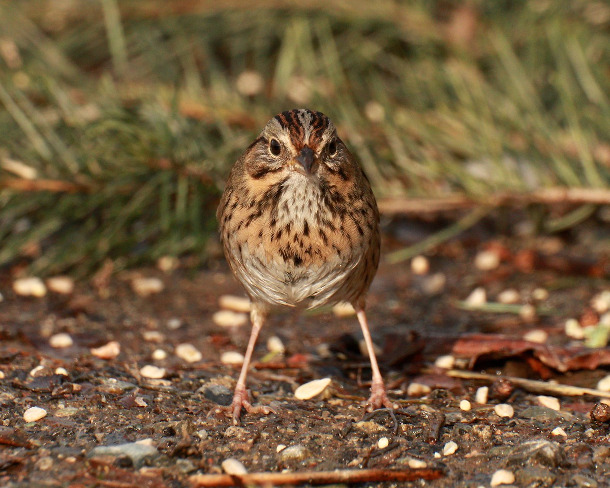
The Lincoln’s Sparrow breeds largely in boreal regions. (Photo: © Gregg Thompson)
The sandpipers called Dunlins now swarm south, to winter along both coasts, by the many thousands. [Dunlin flock calls]
Close behind are the predators—northern-nesting Merlins, Peregrines, and Sharp-shinned Hawks, following south their winged prey. [Loud Dunlin flock calls]
###
Written by Bob Sundstrom
Bird audio provided by The Macaulay Library of Natural Sounds at the Cornell Lab of Ornithology, Ithaca, New York. Sooty Fox Sparrow recorded by L.J. Peyton. Dunlin recorded by W.W.H. Gunn. Call of Song Sparrow by G.A. Keller. Chatter of Mallards by A.A. Allen.
Lincoln's Sparrow recorded by Martyn Stewart, naturesound.org
BirdNote’s theme music was composed and played by Nancy Rumbel and John Kessler.
Producer: John Kessler
Executive Producer: Chris Peterson
© 2015 Tune In to Nature.org October 2014/2017 Narrator: Michael Stein
ID#101606return2KPLU autumn-02b
https://www.birdnote.org/listen/shows/october-migrants-look-whos-back
CURWOOD: For pictures, fly on over to the Living on Earth website, loe dot org.
Related link:
October Migrants on the BirdNote Website
[MUSIC: Desert Dwellers, “Longing For Home” on Breath, by Desert Dwellers, Black Swan Sounds]
Urban Farming During COVID
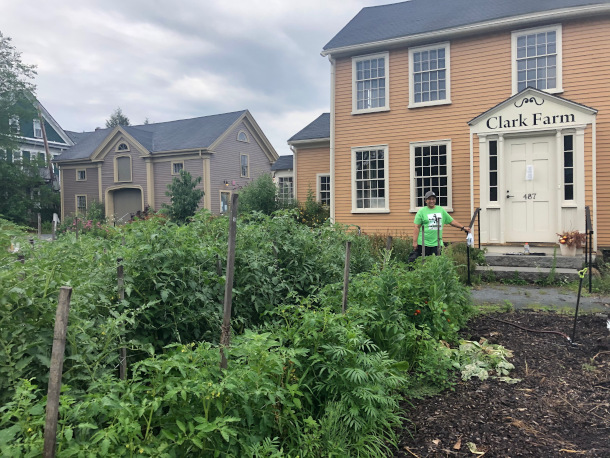
Patricia Spence stands in Clark Farm, one of the earliest intact examples of agricultural property in an urban space in Massachusetts. (Photo: Courtesy of Bruce Gellerman, WBUR)
CURWOOD: During World Wars One and Two the US government encouraged people to plant victory gardens to grow their own food as a way to support the war effort.
The nation’s oldest continually operating Victory Garden is in Boston and across the city modern urban farms carry on the tradition of growing hyper local food for residents.
The farms were growing in size and scale but had to adjust operations when the Covid19 pandemic hit. WBUR reporter Bruce Gellerman has the story.
GELLERMAN: America’s industrial farms are highly efficient at feeding the nation but that efficiency comes at a high cost in terms of climate emissions. It’s estimated most foods travel an average 1500 miles before arriving on your plate. But in some Boston neighborhoods the distance from farm to fork can be as close as a few feet. Urban farming is at the heart of what you can do about climate change. Jane Hirschi runs City Sprouts. It’s a hands-on environmental science program for public schools in Cambridge and Boston. Hirschi says she teaches students how to grow food in small urban spaces….and raise a little hell.
HIRSHI: Having a local food system in the city that you can walk to, that’s about the most radical thing you can do, but it also makes it a radical thing place for everyone who can see it happening. It’s like spreading the idea of empowerment.
[Sfx ---farm/street sound]
Hirshi sits at a picnic table in the shade, with her long time friend Pat Spence, Executive Director of The Urban Farming Institute. Spence says they meet once a month to talk all things urban-ag at the Institute’s headquarters.
SPENCE: “It is an oasis and that’s how we feel,” laughs Spence ….yeah, it truly is, hahah right in Mattapan.
GELLERMAN: Amid traffic on Norfolk Street and triple decker houses, the Urban Farming Institute sticks out like a green thumb. It’s built on a small corner of what used to be a 330 acre 18th century estate.To make the land safe for farming-free of lead contamination and oil from old leaky,underground tanks,the soil was removed 18 inches deep, covered with a special rain permeable material and filled in with new dirt and compost. The soil is tested twice a year.Today the one acre farm is lined with perfectly manicured rows offering 60 varieties of vegetables:
SPENCE: Various types of kale and collard greens, various types of peppers, tomatoes,squash , zucchini……...fade under KEEP…
In between rows of veggies are marigold plants and basil…
SPENCE: That’s how we deal with the pests….hahaha...the bugs etc..they don’t like basil they don’t like marigold...and there are other plants we use to send the bugs on their way.
GELLERMAN: The crops aren’t certified organic but ARE raised following the strict rules spelled out in the 2013 Boston “Right to Farm’ zoning ordinance which permitted commercial farming in the city....and the start of the Urban Farming Institute.
Sfx road…
GELLERMAN: Pat Spence predicted a bumper crop this year…the institute even built a new field in the neighborhood.
SPENCE: The whole community came we had sixteen raise beds we built a farm in a day.
GELLERMAN: But now the new field lays fallow. When the pandemic hit…and restaurants closed, the Institute lost its commercial customers for it’s locally grown produce.
Then the main distribution operation, shut down when the parking lot was turned into a drive -in covid testing station.
[SFX Street/general field sound]
GELLERMAN: Now Urban Farming sells and distributes food at local farmers markets --when and if they’re open...and from the Institute’s headquarters where customers buy just harvested produce by the bagful.
CUSTOMER VOICE: Oh boy, we came to get the fresh grown vegetables here today, corn and spinach a lot of stuff. The covid is crazy.
GELLERMAN: Has it affected the way you buy food?
CUSTOMER VOICE: Oh yeah, oh yes.
GELLERMAN: The Farming Institute caters to the different cultural tastes of its diverse communities, growing kuza squash for Cape Verde dishes, long green and yellow beans for South East Asian cuisine. Then there’s red root pigweed also known as Metis Spinach. The bitter lemon tasting leaf- is a main ingredient in a Jamaican dish called Callaloo. Percess Williamson leaves the urban farm with a big bag of the greens.
GELLERMAN: Are you from Jamaica?
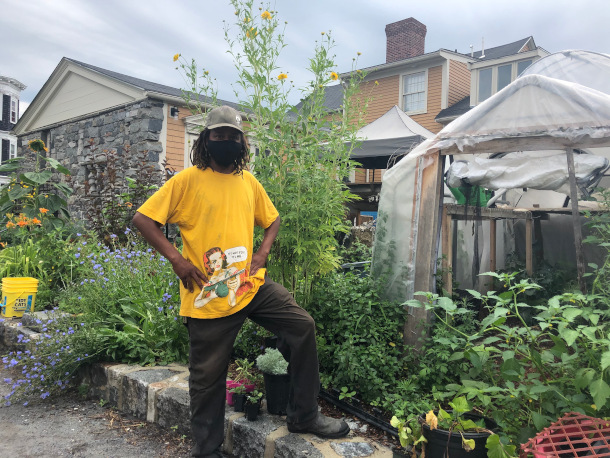
Bobby Walker, among the rows of plants at the urban farming space. (Photo: Courtesy of Bruce Gellerman, WBUR)
WILLIAMSON: I am..Oh you know callaloo? ..yeah callallo and shellfish..I’ll probably cook it for breakfast tomorrow.
GELLERMAN: Williamson recently joined the Farming Institute’s $25 dollar a week Community Supported Agriculture program but even that is too much for many Boston residents hit hard by the pandemic. Hunger is a growing problem. One in 5 Massachusetts families with children are food insecure. That’s almost double the rate a year ago. And nationally some 54 million people may be food insecure this year.
Institute Executive Director Pat Spence:
SPENCE: So they’ve lost family members due to covid they’ve lost jobs ..what can we do..as farmers we’re going to give food away. If someone is in need of food, we’re going to help you. That’s the most important thing we can do at this time.
GELLERMAN: When residents were locked down Spence says, the Urban Farming Institute brought the farm to them.
SPENCE: So we developed for this year the Build On Hundred Grow Boxes Campaign and we built 20 already. and they’re growing their own food.
GELLERMAN: But providing people with fresh, healthy food is only part of the Farming Institute’s mission. It also conducts a twenty week course teaching participants to become farm entrepreneurs.
SPENCE: Those who are interested in learning the art of urban farming...who really want to get their hands in the dirt...and we’ve graduated approximately 170 people since 2013.
GELLERMAN:But this year- because of covid social distancing-just 3 rather than 20 students participated in the farmer entrepreneur program.
Graduates have gone on to start businesses growing flowers and medicinal plants - another operates a hops farm for a local brewery. Bob Walker graduated in the Institute’s first farm- entrepreneur class.
WALKER: We were trying to start a farmers market in our neighborhoood- we lived in Lower Roxbury at the time and we couldn’t get any farmers to come...so I became a farmer... literally that’s what happened.
GELLERMAN: Today Walker is Training Manager at the Urban Farming Institute.
WALKER: That’s what I say all the time we don’t just grow food we grow people. And people change doing this work. When you plant that little tiny seed and you let it grow and get that fruit off it...that’s the same with people..
WALKER: Urban farming is labor and land intensive…which makes it expensive...and just one, small-scale solution to society’s many problems...but perhaps what urban farming really produces is people empowered to raise not just crops but a little hell.
CURWOOD: Reporter Bruce Gellerman’s story comes to us courtesy of WBUR.
Related link:
Read more about the Fenway Victory Gardens
[MUSIC: Occidental Brothers Dance Band International, “Yaa Amponsah” on CDC Sanbra, Traditional/arr.Occidental Brothers Dance Band International, Occidental Brothers]
CURWOOD: Living on Earth is produced by the World Media Foundation. Our crew includes Naomi Arenberg, Paloma Beltran, Jenni Doering, Jay Feinstein, Leah Jablo, Mark Seth Lender, Don Lyman, Isaac Merson, Aaron Mok, Aynsley O’Neill, Jake Rego, Casey Troost, and Jolanda Omari.
BASCOMB: Tom Tiger engineered our show. Alison Lirish Dean composed our themes. You can hear us anytime at L-O-E dot org, Apple Podcasts and Google Podcasts, and like us, please, on our Facebook page - Living on Earth. We tweet from @livingonearth. And find us on Instagram at livingonearthradio. Steve Curwood is our executive producer. I’m Bobby Bascomb. Thanks for listening!
ANNOUNCER: Funding for Living on Earth comes from you, our listeners, and from the University of Massachusetts, Boston, in association with its School for the Environment, developing the next generation of environmental leaders. And from the Grantham Foundation for the protection of the environment, supporting strategic communications and collaboration in solving the world’s most pressing environmental problems.
ANNOUNCER 2: PRX.
Living on Earth wants to hear from you!
Living on Earth
62 Calef Highway, Suite 212
Lee, NH 03861
Telephone: 617-287-4121
E-mail: comments@loe.org
Newsletter [Click here]
Donate to Living on Earth!
Living on Earth is an independent media program and relies entirely on contributions from listeners and institutions supporting public service. Please donate now to preserve an independent environmental voice.
NewsletterLiving on Earth offers a weekly delivery of the show's rundown to your mailbox. Sign up for our newsletter today!
 Sailors For The Sea: Be the change you want to sea.
Sailors For The Sea: Be the change you want to sea.
 The Grantham Foundation for the Protection of the Environment: Committed to protecting and improving the health of the global environment.
The Grantham Foundation for the Protection of the Environment: Committed to protecting and improving the health of the global environment.
 Contribute to Living on Earth and receive, as our gift to you, an archival print of one of Mark Seth Lender's extraordinary wildlife photographs. Follow the link to see Mark's current collection of photographs.
Contribute to Living on Earth and receive, as our gift to you, an archival print of one of Mark Seth Lender's extraordinary wildlife photographs. Follow the link to see Mark's current collection of photographs.
 Buy a signed copy of Mark Seth Lender's book Smeagull the Seagull & support Living on Earth
Buy a signed copy of Mark Seth Lender's book Smeagull the Seagull & support Living on Earth

